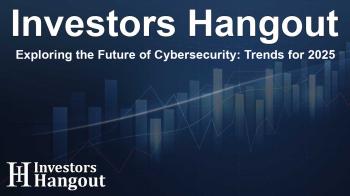Exploring the Future of Cybersecurity: Trends for 2025

Understanding Cybersecurity Trends for 2025
As 2025 approaches, cybersecurity teams must brace themselves for a landscape filled with new threats, challenges, and opportunities. The evolution of technology presents both risks and solutions, making it imperative for organizations to arm their security staff with current knowledge and training to navigate these upcoming trials. INE Security, a leader in cybersecurity training and certification, is shedding light on the key trends shaping security strategies this year.
AI's Role in Cybersecurity
AI-Powered Cyber Threats
Artificial Intelligence is emerging as a game-changer in the cybersecurity realm, serving both as an asset and a potential threat. Cybercriminals are increasingly using sophisticated AI tools, which enable them to build more cunning and adaptive cyber attacks. These advancements lead to highly personalized phishing attempts, automated vulnerability assessment, and complex social engineering methods that can bypass traditional defenses with alarming efficiency.
Zero Trust Security Framework
The conventional model of protective perimeter security is rapidly becoming obsolete. With the rise of distributed workforces, the fragility of cloud systems, and complex IT environments, a new approach is needed. The Zero Trust model emphasizes that no user or system should be trusted automatically, regardless of their origin. As threats can originate from any direction, organizations must adopt a security posture that assumes breaches can happen and prepare accordingly.
Emerging Risks for Organizations
Quantum Computing: A New Frontier
The swift advancements in quantum computing are posing unprecedented risks to traditional cybersecurity measures. As quantum technologies advance, current encryption methods may struggle to withstand complex quantum attacks. The fear that sensitive information may one day be decrypted using quantum capabilities represents a real challenge for industries looking to safeguard their data long-term.
Expanding Attack Surfaces
With the rising popularity of Internet of Things (IoT) devices and edge computing solutions, businesses are becoming vulnerable to an increasingly complex array of security threats. The sheer volume of connected devices presents potential entry points for cybercriminals, while many IoT devices often lack robust security features, contributing to an expanded attack surface that traditional security infrastructures may not efficiently manage.
Compliance and Governance Challenges
Regulatory Frameworks and Cybersecurity
The intertwining of cybersecurity with regulatory compliance highlights the need for sophisticated governance strategies. Businesses are required to stay compliant with an intricate web of data protection policies and cross-border regulations. This reality demands a proactive risk management approach as organizations face the potential for hefty penalties due to non-compliance.
The Need for Training and Development
Amid these evolving cybersecurity challenges, training and preparedness stand out as vital solutions that equip teams to counter emerging threats. Organizations should prioritize investment in hands-on cybersecurity training to empower their workforce. Courses focused on pertinent areas such as Zero Trust principles, identity management, risk assessment, and embedded security systems are critical in ensuring teams possess the skills necessary to defend against sophisticated cyber attacks.
Conclusion: Embracing the Future
As we navigate through 2025, the ever-evolving landscape of cybersecurity demands adaptable and forward-thinking strategies. The importance of comprehensive training and proactive risk management cannot be overstated. Embracing the challenges that emerge from these trends can serve as an opportunity for organizations to innovate and enhance their defenses. INE Security remains committed to leading the endeavor for empowering cybersecurity teams worldwide by equipping them with the knowledge to secure their digital assets effectively.
Frequently Asked Questions
What are the main cybersecurity trends for 2025?
Key trends include AI-driven threats, Zero Trust architecture, quantum computing risks, the expansion of IoT devices, and enhanced regulatory compliance requirements.
Why is Zero Trust important?
Zero Trust is crucial because it assumes that threats can originate from anywhere, and no entity should be trusted automatically, making systems inherently more secure.
How does quantum computing impact cybersecurity?
Quantum computing poses a threat to traditional encryption methods, potentially allowing attackers to decrypt sensitive data previously thought secure.
What is the expanded attack surface?
The expanded attack surface refers to the increased vulnerability of systems due to the rise of connected IoT devices and edge computing, exposing more entry points to attackers.
How can organizations prepare for these cybersecurity challenges?
Organizations can prepare by investing in rigorous cybersecurity training, adopting a Zero Trust approach, and developing robust compliance strategies to mitigate risks.
About Investors Hangout
Investors Hangout is a leading online stock forum for financial discussion and learning, offering a wide range of free tools and resources. It draws in traders of all levels, who exchange market knowledge, investigate trading tactics, and keep an eye on industry developments in real time. Featuring financial articles, stock message boards, quotes, charts, company profiles, and live news updates. Through cooperative learning and a wealth of informational resources, it helps users from novices creating their first portfolios to experts honing their techniques. Join Investors Hangout today: https://investorshangout.com/
Disclaimer: The content of this article is solely for general informational purposes only; it does not represent legal, financial, or investment advice. Investors Hangout does not offer financial advice; the author is not a licensed financial advisor. Consult a qualified advisor before making any financial or investment decisions based on this article. The author's interpretation of publicly available data shapes the opinions presented here; as a result, they should not be taken as advice to purchase, sell, or hold any securities mentioned or any other investments. The author does not guarantee the accuracy, completeness, or timeliness of any material, providing it "as is." Information and market conditions may change; past performance is not indicative of future outcomes. If any of the material offered here is inaccurate, please contact us for corrections.
